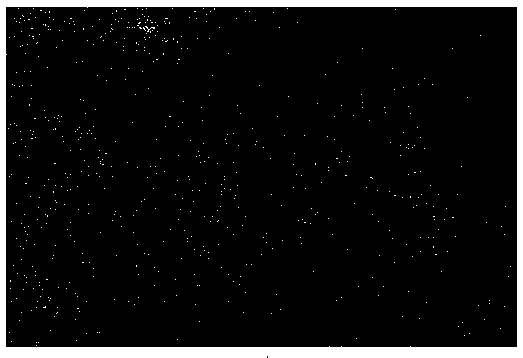Method for in-situ biosynthesis of multifunctional metal nanoprobe from tumor cells
A metal nanoprobe and tumor cell technology, applied in the field of material preparation, can solve the problems of toxicity and cell death, and achieve the effect of good biocompatibility
- Summary
- Abstract
- Description
- Claims
- Application Information
AI Technical Summary
Problems solved by technology
Method used
Image
Examples
Embodiment 1
[0025] A method for biosynthesizing multifunctional metal nanoprobes in situ with tumor cells, the specific steps are as follows: place HepG2 cell lines in DMEM medium containing 10% fetal bovine serum (streptomycin 100 gg / mL, penicillin 100 IU / mL) in a culture flask at 37°C in an incubator containing 5% CO2 and 95% humidity. After the cells adhere to the wall, add chloroauric acid solution (10-20 μM in the culture flask) to the culture flask, and after 12 hours of incubation, continue to add a certain concentration (for example, 10 μM) of DNA strands to the culture flask, After incubation for 12 hours, the incubated HepG2 cells were extracted by centrifugation at a rate of 2000 r / min, and the incubated HepG2 cells were washed with 10 mM barbital sodium-hydrochloric acid buffer solution for 3-5 times, and the washed cells were crushed. The incubated HepG2 cells are separated and extracted from the multifunctional gold nano-probes in the incubated HepG2 cells.
[0026] figur...
Embodiment 2
[0028] A method for biosynthesizing multifunctional metal nanoprobes in situ with tumor cells, the specific steps are as follows: Place liver cancer (HepG2) cell lines in DMEM medium containing 10% fetal bovine serum (streptomycin 100 gg / mL, penicillin 100 IU / mL) in a culture flask at 37°C in an incubator containing 5% CO2 and 95% humidity. After the cells adhere to the wall, add silver nitrate solution (10-20 μM in the culture flask) to the culture flask, and after 12 hours of incubation, continue to add a certain concentration (for example, 10 μM) of DNA strands to the culture flask, and incubate After 12 hours, the incubated HepG2 cells were extracted by centrifugation at a rate of 2000 r / min, and the incubated HepG2 cells were washed 3-5 times with 10 mM phosphate (PBS) buffer solution. the HepG2 cells, and separate and extract the multifunctional silver nanoprobes in the incubated HepG2 cells.
Embodiment 3
[0030] A method for biosynthesizing multifunctional metal nanoprobes in situ with tumor cells, the specific steps are as follows: place HepG2 cell lines in DMEM medium containing 10% fetal bovine serum (streptomycin 100 gg / mL, penicillin 100 IU / mL) in a culture flask at 37°C with 5% CO 2 , cultured in an incubator with 95% humidity. After the cells adhere to the wall, add zinc gluconate solution (concentration in the culture flask is 10-20 μM) to the culture flask, and after incubation for 12 hours, continue to add a certain concentration (for example, 10 μM) of DNA strands to the culture flask, After incubation for 12 hours, extract the incubated HepG2 cells by centrifugation at a rate of 2000 r / min, wash the incubated HepG2 cells with 10 mM Tris-hydrochloric acid buffer solution for 3-5 times, break and wash the incubated HepG2 cells cells, separating and extracting the multifunctional zinc nano-probes in the incubated HepG2 cells.
PUM
| Property | Measurement | Unit |
|---|---|---|
| particle diameter | aaaaa | aaaaa |
Abstract
Description
Claims
Application Information
 Login to View More
Login to View More - Generate Ideas
- Intellectual Property
- Life Sciences
- Materials
- Tech Scout
- Unparalleled Data Quality
- Higher Quality Content
- 60% Fewer Hallucinations
Browse by: Latest US Patents, China's latest patents, Technical Efficacy Thesaurus, Application Domain, Technology Topic, Popular Technical Reports.
© 2025 PatSnap. All rights reserved.Legal|Privacy policy|Modern Slavery Act Transparency Statement|Sitemap|About US| Contact US: help@patsnap.com


